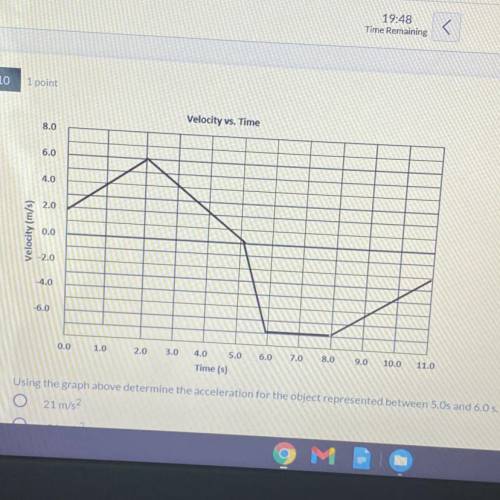
Physics, 28.08.2021 02:50 20guadalupee73248
Using the graph above determine the acceleration for the object represented between 5.Os and 6.0 s.
21 m/s2
-21 m/s2
-7.0 m/s2
1.2 m/s2


Answers: 2


Other questions on the subject: Physics

Physics, 22.06.2019 03:30, munchyswish
Astudent is working in the lab to determine how time affect impulse the student keeps the force the same in each row but changes impact the time some data is shown witch trial has the greatest a student is working in the lab to determine how time affect impulse the student keeps the fours the same in each row but change is the impact time some data shown witch trial has the greatest impulse
Answers: 3

Physics, 22.06.2019 16:30, amayareyes101
Large electric fields in cell membranes cause ions to move through the cell wall. the field strength in a typical membrane is 1.0 x 10 7 n/c. what is the magnitude of the force on a calcium ion with charge +e? what is its acceleration? is it possible for a particle with the same charge as as calcium to have a different acceleration if placed at this location? what would change the acceleration: mass of the particle? diameter of the particle?
Answers: 2

Physics, 22.06.2019 17:40, yoongnzl
Aspring is used to stop a 50-kg package which is moving down a 20º incline. the spring has a constant k = 30 kn/m and is held by cables so that it is initially compressed 50 mm. knowing that the velocity of the package is 2 m/s when it is 8 m from the spring and neglecting friction, determine the maximum additional deformation of the spring in bringing the package to rest.
Answers: 1

Physics, 22.06.2019 19:30, rprest00
Amass m = 74 kg slides on a frictionless track that has a drop, followed by a loop-the-loop with radius r = 18.4 m and finally a flat straight section at the same height as the center of the loop (18.4 m off the ground). since the mass would not make it around the loop if released from the height of the top of the loop (do you know why? ) it must be released above the top of the loop-the-loop height. (assume the mass never leaves the smooth track at any point on its path.) 1. what is the minimum speed the block must have at the top of the loop to make it around the loop-the-loop without leaving the track? 2. what height above the ground must the mass begin to make it around the loop-the-loop? 3. if the mass has just enough speed to make it around the loop without leaving the track, what will its speed be at the bottom of the loop? 4. if the mass has just enough speed to make it around the loop without leaving the track, what is its speed at the final flat level (18.4 m off the ground)? 5. now a spring with spring constant k = 15600 n/m is used on the final flat surface to stop the mass. how far does the spring compress?
Answers: 3
You know the right answer?
Using the graph above determine the acceleration for the object represented between 5.Os and 6.0 s....
Questions in other subjects:

History, 25.02.2021 23:20

Social Studies, 25.02.2021 23:20

Spanish, 25.02.2021 23:20


Arts, 25.02.2021 23:20


Mathematics, 25.02.2021 23:20

Chemistry, 25.02.2021 23:20


Mathematics, 25.02.2021 23:20



